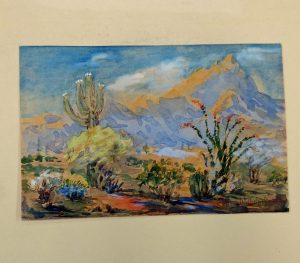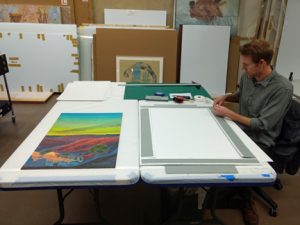
 Published on August 28, 2021 in the Arizona Daily Sun
Published on August 28, 2021 in the Arizona Daily Sun
Though painted nearly 90 years ago, the watercolor landscape recently donated to the Museum of Northern Arizona remains vibrant with washes of red dirt, blue skies, and orange sunlight glinting off the Piestewa Peaks. But lift the mat holding this painting and you’ll spot a problem. Natural acids in the mat have begun to discolor the edges of the paper. Luckily, now that the painting is part of the museum collections it is one of 2,044 works on paper about to be rehoused through a $343,812 grant from the National Endowment for the Humanities. This three-year project will preserve these artworks for future generations, by creating a more stable environment to slow the chemical processes of degradation.
There’s a science to preserving art. Though many people think of art as something framed and hung on a wall, that actually can harm watercolors, drawings, etchings, and other works of art on paper. Even in a frame, the paper can warp. When exposed to light, the colors fade. And standard mats are almost always made with wood pulp, which contains acids that cause paper to yellow, become brittle, and turn brown overtime, as if burned. It’s the same reason old paperback books yellow with age.
Art in the museum’s collection is already better off than a paperback on a shelf or a painting on a wall, because it is stored in MNA’s state-of-the-art Easton Collection Center. Opened in 2009, the collection center is constructed to provide the highest level of protection and preservation. Maintaining a stable temperature and humidity within the building slows the chemical reactions that cause degradation. The NEH-funded rehousing project will add more levels of protection for the painting of Piestewa Peaks and other delicate works on paper, starting with the mats that hold them.
In 2015 Conservator Rachel Freer-Waters surveyed the MNA fine arts collection through a grant from the Institute of Museum and Library Services. She determined that some of the artwork was warping or discoloring from being stored in the original frames and mats. This is not unusual. Today more than 95% of paper products are made with wood pulp, which contains natural acids. Those are prone to acid hydrolysis reaction, which causes the yellowing and degradation. Even papers that start out chemically neutral become more acidic as they age, because the cellulose in the paper generates acids. Paper from several hundred years ago actually degrades more slowly, because before the mid-19th century most paper was made from cotton and linen rags.
The tapes and adhesives used to mount artwork before framing also tend to be acidic. Over the years, these chemically unstable materials take their toll. The NEH grant will allow MNA to replace the existing mats with archival presentation mats, which provide protection from abrasion and deformation. MNA previously used funding from the Southwestern Foundation to conduct pilot tests on techniques and determine time required to create a presentation mat. The presentation mats will be made out of two pieces of acid-free, four-ply cotton rag mat board. The top mat board will have a window cut so the art can be seen without disturbing it. Unbuffered interleaving tissue is placed between the art and the top window mat to protect the surface from potential abrasion.
Any artwork that has residue from acidic adhesive or old tape will be secured to the mats with corners. Like corners used in older photo albums, these will hold the artwork for storage or exhibit purposes while allowing the artwork to be easily accessed for the delicate process of removing the residues.
Once safe within archival presentation mats, the artwork will be placed flat in specially designed boxes with fitted lids and then stored in closed cabinets. These many layers of protection create a microclimate with consistent temperature and humidity, allowing the orange sunlight to continue glowing from the Piestewa Peaks for another century.
